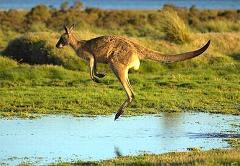One reason kangaroos don’t run is because they can’t run, even if they wanted to really badly.

To move at slow speeds, a kangaroo performs crawl-walking by using its tail to form a tripod with its limbs, and raises its hind feet forward to move.
Their legs have evolved to a point where they’re completely unsuited for doing so. Luckily, when the lush Australian rain forests dried up and became desert, kangaroos were particularly well suited to the terrain.
Most Kangaroos can hop at about 25 mph comfortably, but speeds of up to 44 mph can be achieved.
Kangaroos needed to be able to travel great distances to find the quantities of food they required, to support their large bodies, and hopping requires about 25 percent less energy than an animal of similar size uses when running.
To add to its energy efficiency, a kangaroo’s digestive organs bounce backward and forward with each hop.
How does this help?
Well, the back-and-forth lurching mechanically pumps its lungs, saving the energy that kangaroos normally have to expend for breathing in and out.
